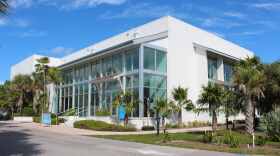Southwest Florida’s growing population and rapid development means there’s always a construction project happening. But due to our coastal location, we’re also one of the hurricane capitals of the world.
Dean Ramineh, Manhattan Construction’s safety manager for the region, says hurricanes can do more than just damage in-progress buildings.
"It’s not only damage done to a building, damage done to potential projectiles that might leave a job site and hit other neighbors, or whatever is around the neighborhood of what we're building," Ramineh said.
Ahead of a hurricane, materials and garbage that can become airborne are secured down, or stored at an indoor warehouse.
Manhattan’s hurricane plan comes in time-based phases. Phase one aims to make clients and employees aware of a projected storm, with phase two subduing production if landfall may be close to the area. Manhattan takes photos of projects before landfall to reference after the storm when checking for damage.
Phase three, about 72 hours before the storm, is when things come to a screeching, but necessary halt.
"Production stops, everything, no deliveries, no nothing," Ramineh said. "No one's allowed to put a nail in a two-by-four."
Phase four, starting 48 hours before landfall, has workers depowering sites, securing projectiles, and going home to prepare with their families.
Of all informative methods, Manhattan developed an app for employees. There’s a section for storm-specific information, an emergency contact list, a way for employees to notify supervisors of their evacuation plans, and more.
Craig Bryant, vice president of the company’s Southwest Florida operations, said employee safety gets priority over project timelines.
"We will shut jobs down earlier than some just to make sure that folks not only aren't working in unsafe conditions, but they can go home and make their homes hurricane safe or safely get out of the area if there's a need to evacuate," Bryant said.

Bryant added that every storm has been a learning experience for the company. In the case of Ian, Manhattan Southwest Florida procured materials from other Manhattan regions.
Beyond projects in direct flood zones, and maybe a broken window or door, the company’s standard for building prevents major damage or delays. Project Superintendent Paul Schmid attests to that.
"You can see, our structure is a fully concrete structure with reinforced masonry on the exterior," Schmid said. "We primarily do commercial and healthcare projects, so our projects will more tend to be like the one that we are on currently. It's going to withstand pretty much any storm that we're going to get."
Manhattan says most if not all construction companies have a plan similar to theirs.
WGCU is your trusted source for news and information in Southwest Florida. We are a nonprofit public service, and your support is more critical than ever. Keep public media strong and donate now. Thank you.














